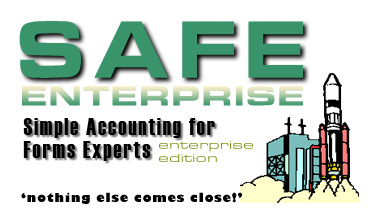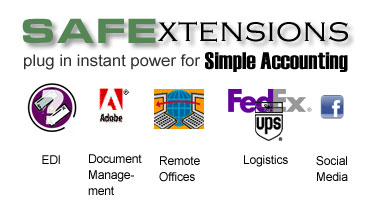Requests for Vendor Quotes
 The RFQ browse holds a list of each Product you have requested pricing on from one or more Vendors and the customer or prospect Contact for whom you made the request. Each RFQ can contain up to three quantities to be bid. Like all Simple Accounting transactions, an RFQ consists of two objects: A header and line items.
The RFQ browse holds a list of each Product you have requested pricing on from one or more Vendors and the customer or prospect Contact for whom you made the request. Each RFQ can contain up to three quantities to be bid. Like all Simple Accounting transactions, an RFQ consists of two objects: A header and line items.
When you enter a new RFQ, you begin by entering the header, which contains information regarding what and who:
-
The what is the Product to be quoted, which may be an existing product, or a new item based on specs from an existing product. (There is a lot in that sentence; well come back to it in a minute.)
-
The who refers to the company for which the product is being ordered. This could be your company, an existing customer, or a new prospect. (These are selected from your Contacts file).
Attached to each of these transaction headers are one or more line items. Each line represents a Vendor from whom you are requesting pricing, plus the shipment method and requested lead time.
Procedure
The quote process consists of four basic steps:
1. Entering the quote (covered in the next topic, Entering and Printing RFQs).
2. Printing the quote and sending these to your vendors (also covered in Entering and Printing RFQs).
3. Entering the pricing into the RFQ once you receive a response from your vendor(s) (covered in the (Converting RFQs To Sales Orders & Quotes) topic .
4. Converting the RFQ to either:
-
A Sales Order by selecting a single vendor from the RFQ who gets the job.
-
A Sales Quote by selecting the best price/delivery options from one or more of the vendors on the RFQ.
Requests for Quotes are displayed in red, green or black in this browse depending on where they are at in the quote cycle. Green records are for items that have been printed, but not yet accepted. Red records are also for items which have not been accepted but whose Respond By date has already past without accepting the RFQ. In other words, they are past due and require immediate attention. All other records (accepted RFQs and voids) are displayed in black.
Deleting Rejected And Accepted RFQs
Unprinted RFQs or printed RFQs older than the RESPOND BY DATE field and which have not been accepted may be deleted at any time by pressing <Del>.
Printed RFQs which have not been accepted may be deleted after the RESPOND BY DATE.
Accepted RFQs may be deleted. However, you may wish to maintain these so that you can compare quotes received at various times.
Automatically Creating RFQs
Simple Accounting can also automatically create RFQs from the INVENTORY|Reorder Notices browse. Since the program has already built a list of products it (and you) decide need to be reordered, why not send out the RFQs automatically? In that case, the RFQ is generated with one line item; the default vendor ID set in FILES|Products.
Printing Reports
The [Print] button lets you select two types of reports for the RFQs displayed in the current browse:
Summary Report This report lists each RFQ with its line items underneath. This gives you a complete printed record of each RFQ. The RFQs are printed in the order of the browse and for all records displayed in the current browse tab.
Detail Report The prints one line for each vendor and the report is sorted and subtotalled by vendor, then Product ID. As with the Summary Report, the records are limited to RFQs in the current browse.
Example: If you wish to print a report of only printed RFQs which have not been accepted, simply select the [Open RFQs] tab, then press [Print], then [Detail]. This tells you at a glance which items you have not received a reply back from which vendors.
Example: If you need a list of printed RFQs which have not been responded to by the RESPOND BY date, do the following:
1. Press the [Queries] tab and press the [Query] button.
2. Press the [Build New] button.
3. Enter RESPOND BY DATE < and todays date in Filter Criteria #1.
4. Enter STATUS = P in Filter Criteria #2.
5. Press [Proceed]
6. Press [Do Not Save] in the Queries Browse
7. Press [Print], then [Detail] to print the report.
The [Print] button also lets you print a request sheet for each tagged vendor on the RFQ. This is convenient for re-printing an RFQ, but we still recommend the procedure in the following section for general use.



